Filmed November 1982
Come join me again
at
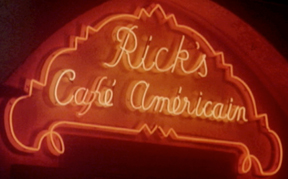
What a difference a few weeks can make!
When I completed photography on WHO AM I KILLING?, the feeling in the company was very positive and hopeful. It was the second show in the can of a five episode limited series, and the feeling was very optimistic that CASABLANCA would be on NBC’s schedule the following season; that it was being produced by David Wolper’s production company was an enormous plus. I stayed on at the studio, finishing my director’s cut, at which time producer Charles Fitzsimons asked me to direct the fifth and final episode of the series. I don’t know what created that vacancy; one director had been booked to direct episodes 1, 3 and 5; I had been booked to direct episode 2; and a third director had been booked to direct episode 4. Since directing WHO AM I KILLING? had been a very positive, pleasant experience, there was no hesitation on my part to saying yes.
Once I started preparing, I noticed immediately a change in the atmosphere. WHO AM I KILLING? had gone over the eight-day shooting schedule by one day. I don’t know if there were overages on the other episodes (I’m positive there were) and if so what they were, but Charles told me the studio was no longer as confident of having the series picked up by the network, they didn’t want to add to the deficit spending they had so far experienced, so they wanted the last episode to be completed in the allotted eight days. Since the new show did not have a difficult location action sequence like the Indian Dunes sequence in WHO AM I KILLING?, I didn’t foresee any problem.
The chances of casting a trained belly dancer with the necessary acting chops for the leading guest role were several levels below probable. We met Melinda Fee, who could dance but was not a belly dancer, so we hired an accomplished belly dancer to choreograph the routines, coach Melinda, and since the set wasn’t large enough for me to photograph the real belly dancer in wide-angle shots, Melinda danced in those shots and for her close-ups, and we filmed the closer body angles of the choreographing belly dancer from the neck down.
So before we get back to the Blue Parrott, where the belly dancer is performing, let’s drop in again at what had become one of my favorite nightspots, Rick’s Cafe Americain. We only had one song to prerecord for this episode, but it was a good one, especially with the great Scatman dishing out the vocals!
For our third day of filming we returned to the Disney studio, where I confronted a major problem in the script. This movie (and I considered of all of them to be short movies) was a caper film. What does a director do when the plan for the caper is more than unrealistic? I was faced with that same question several years earlier when filming THE TRAIN on MISSION: IMPOSSIBLE. (You can read or reread about that caper in the archives via the index to the left of this column.) Well my method of dealing with the dilemma is to cast aside all doubts, BELIEVE that IT IS POSSIBLE, and then put that belief on film realistically. It worked before. THE TRAIN was MISSION: IMPOSSIBLE’s submission to the Television Academy that first season, and the series won the Emmy as Outstanding Dramatic Series.
The first two shots in the interior of the Banque de Maroc…
…were our opening shots the eighth and final day of filming, and at 7:30 am director of photography Joe Biroc hadn’t arrived on the set. I was told that one of the crew drove him to and from the studio, and that I shouldn’t be concerned, but I was. After all he was 79 years old, and that was when I thought 79 was old. So we proceeded without Joe, the gaffer lit the set, the camera operator set up the camera, and as we finished the second shot, Joe arrived, bright and cheerful, and we finished our last day together.
For years I had heard raves about the commissary at the Disney studio. On WHO AM I KILLING? we only had night shooting on the lot. This time we were scheduled for a full day. But at noon we had the catered truck to feed us, and I still didn’t get to eat in the Disney dining room.
Not all of the good lines out of the mouths of actors come off of the screenwriter’s typewriter; Rick’s last line: “Watch you don’t wear yourself out,” was added by David Soul.
One producer I worked for wanted everything covered in close-ups. Now in the early days of television with the smaller screen sets, there may have been some justification for this overuse of the close-up. I certainly liked to use them, but with discretion. In the case of the previous scene between Rick and Claude, I wanted to play it in an uninterrupted shot without any coverage. I was fortunate to have in Charles Fitzsimons a producer who understood the language of film. In addition to the dialogue revealing Claude’s explanation for his involvement with Senorita Inez, we visually see him as if trapped in a cage with Rick ominously encircling him.
Rick had a table in the cafe with a chess set on it, a table he used almost as an in-house office. I’m sure it was photographed in every episode. Joe Biroc came to me and excitedly told me there was an angle in the set that had not yet been filmed. He showed me where a wall could be taken out, giving a new view of Rick and his table. I enthusiastically jumped at the chance to use it.
During one of our casting sessions, the name of Isabella Rossellini was suggested to play Queenie, the belly dancer. David Wolper rejected the idea. He felt it would be tasteless; it would seem that we were using her to capitalize on the fact she was Ingrid Bergman’s daughter, and we all know Bergman’s connection to CASABLANCA. I now wonder if there wouldn’t have been some value in that casting. Isabella Rossellini looked remarkably like her mother, so that Queenie’s resemblance to Ilsa, Rick’s long-ago love, might have been very interesting.
Does anyone remember Astrid Allwyn? She was a movie star (mostly in B movies but some small roles in A features) from the early thirties till the early forties. Melinda Fee, our gambling-losing belly dancer, was her daughter
This was the first time I worked with Andra Millan (Babette). She came in to audition, and revealed a very good French accent. I’m not sure, but I vaguely remember that she came from Texas. We would work together again three years later when she was one of the students on PAPER CHASE, which will be arriving on this site soon.
Before the scene when Queenie comes to see Rick in his demolished bar, Melinda came to me, concerned about her make-up. It was very bold, and if worn on the street would look like the make-up of a streetwalker. I said, “Let’s go show Joe.” We did, and Joe Biroc gave it his approval. As you’ll see, she photographed beautifully.
The make-up man on the show was “Shotgun” Britton, one of the real old-timers in the profession. He was loaded with great expressions, one of which I have stolen and have used for years. When describing a person of lesser mental capability, “Shotgun” would say of him, “He’s two bricks short of a full load.” “Shotgun” certainly wasn’t missing any bricks.
You would have thought that after directing film for twenty-one years, there wouldn’t be any more ‘firsts’ for me. Well, you would have been wrong. Midway through production my friend Charlie Fitzsimons threw me an inside curve. Our script was running long, and in order to finish on schedule some possible cuts needed to be made. Since the scenes that could be cut were scenes in which Rick appeared, Charles and Harold Gast were fearful this might become an issue of contention with David Soul. The potential cuts were pointed out to me. They would remain in the published script, but I needed to plan my filming as if they weren’t there. But if time allowed, they would be filmed, so I also needed to plan for their inclusion. I always planned my ‘bridges’ from scene endings to scene beginnings very carefully. So now in those places where a scene might be cut, I had to plan an ending of the preceding scene that could match either of two beginnings. Here are those designated scenes:
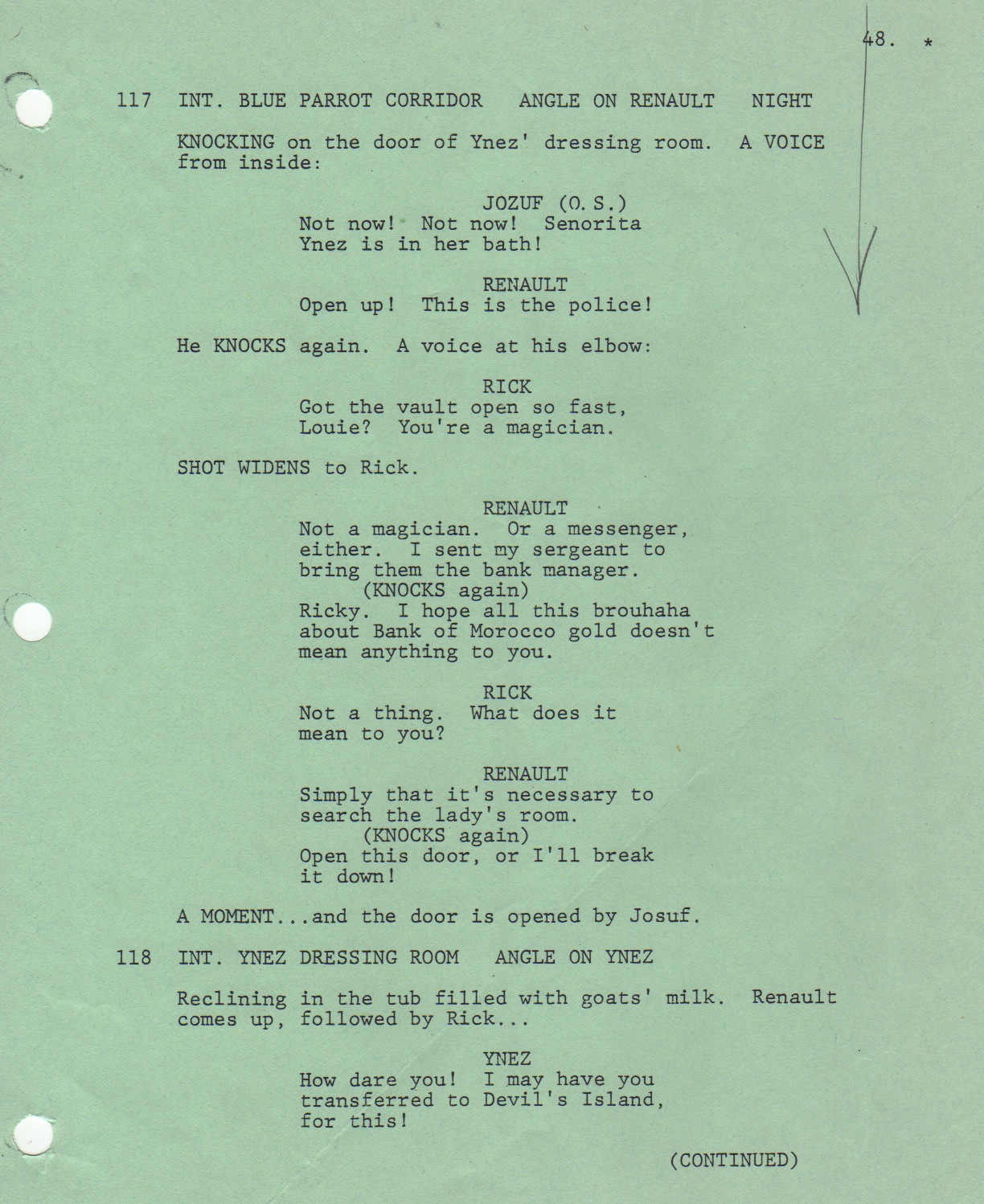
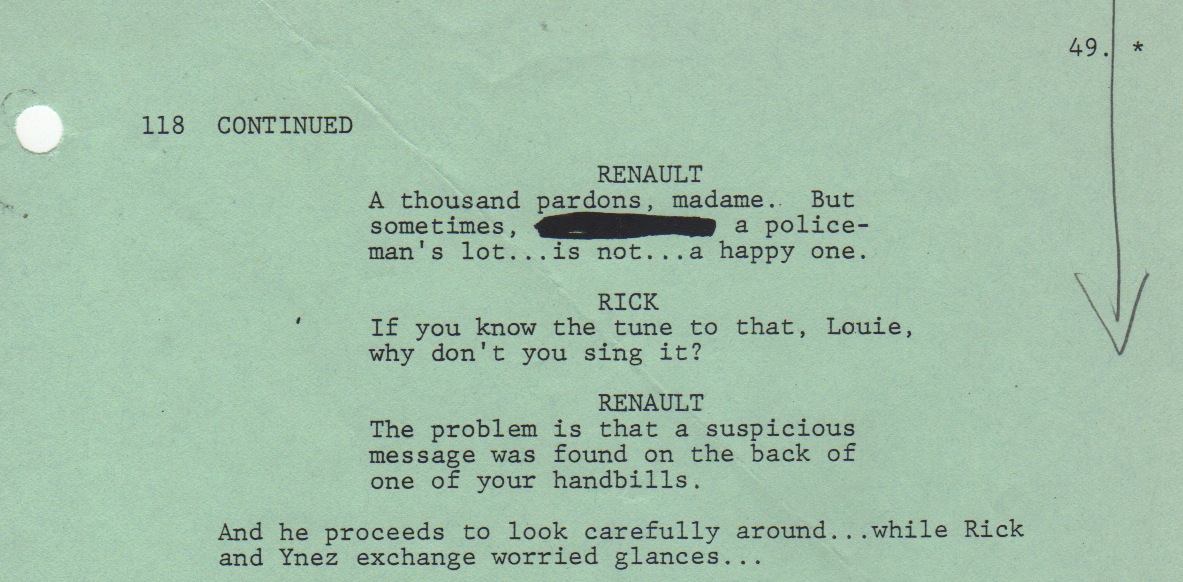

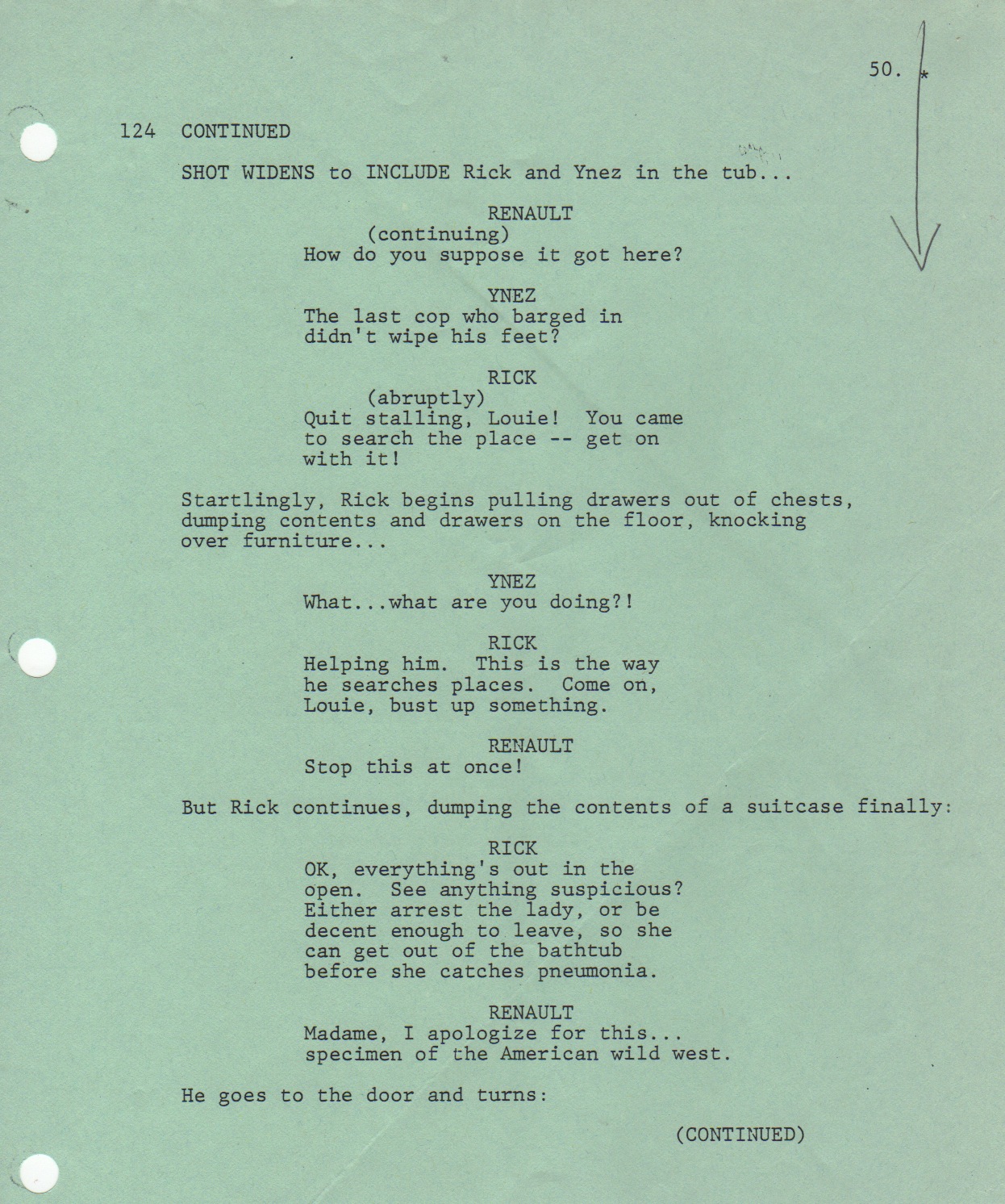
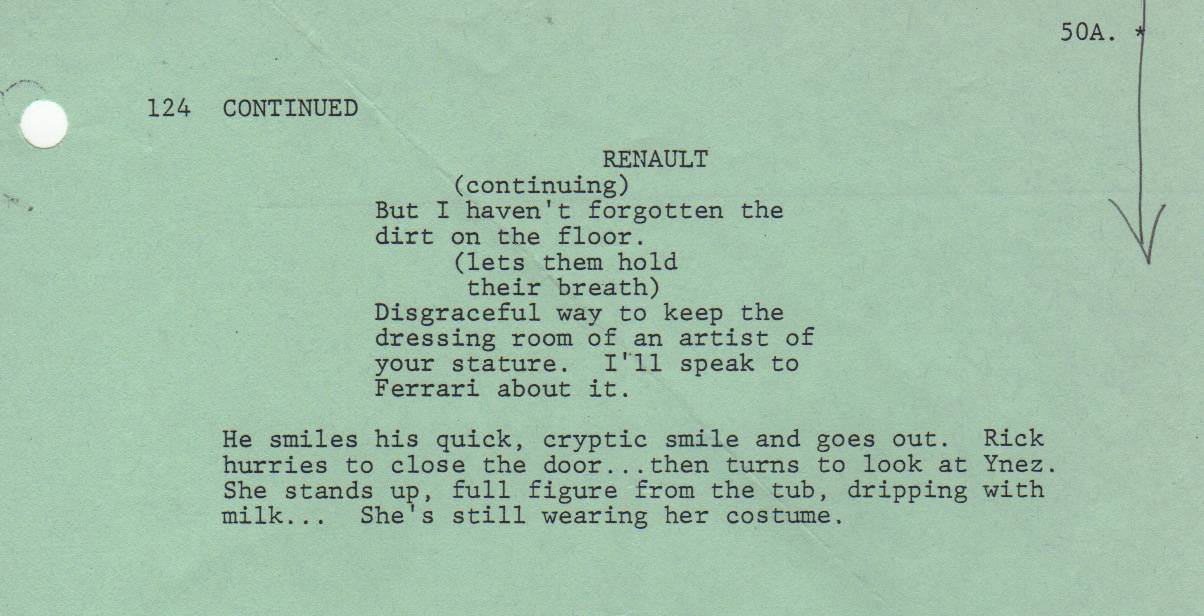
Those scenes were never filmed, but after I left, they realized an added scene was needed to justify the bank manager’s sudden appearance at the banque. David was called back (check how long his hair is) to photograph the following.
Oh that Joe Biroc. His enthusiasm, his ingenuity, his knowledge of his craft never ceased to excite me. At the main entrance to the Banque de Maroc when the bank manager was unlocking the door for the Nazis, to film a close angle on the bank manager, I would only have been able to photograph him and would have had to film a separate shot of the group behind him. But I wanted do it in one shot. So Joe took the door and its frame out of the wall and angled it to provide an interesting composition that included the bank manager, the group behind him with the street in the background.

There were two safe doors to the room where the gold was stored. Two-time Academy Award winner (and six more times nominated) Preston Ames had designed the set according to specifications of research. The first safe door was a smaller door and the safe door into the final chamber was a very large door. Harold Gast, Supervising Producer for the series, came to inspect the sets. He thought the larger door should be the first door. Preston explained to him what his research had revealed. Harold was not to be convinced. He didn’t think it looked real. I remember that moment as being very painful. Preston Ames, a seventy-six year old man who had been a giant in the movie profession, a man whose knowledge and taste should have been revered, he was being forced to redesign the set to please Harold. If this seems as if I’m picking on Harold Gast, I’m not. Harold was my friend and I really liked him. But he like so many of the television writers who were elevated to producer status, did not have the background in production to prepare them for their new duties. And he, like so many of his contemporaries, didn’t adjust and adapt to his new role as producer.
Abby Singer was an assistant director, then a production manager, then a producer, but always one of the nicest people in the profession. As the filming approaches the end of a day’s shooting, it is the assistant director who calls out, “This is the last shot.” When Abby was an assistant director he constantly, after his last shot had been completed, would say, “Oh, there’s one more.” So what had been intended to be the last shot turned out to be the next to the last shot. As a result the next to the last shot of the day came to be known as the “Abby”. He is known internationally. Film students from around the world would come to Universal Studio to meet the famous Abby. So in honor of Mr. Singer, you have just viewed the “Abby” for this post.
CASABLANCA did not become a weekly series. From the advantage point of over thirty years later I now wonder if the very thing that launched the project may have ended up being the thing that sank the ship — the name CASABLANCA. This was not the first attempt to make a series out of the screen classic. Warner Bros. had tried and failed in 1955. And it was not the last. Twenty-two episodes of a series called CASABLANCA were filmed in 1998 in Argentina. So maybe there are some screen classics that defy being remade. But was the series given a chance? NBC aired only three of the five episodes in April 1983, and the following month when the fall season was announced, CASABLANCA was not on it. The other two episodes aired in late summer. That was hardly an opportunity for the show to find and build an audience.
On the other hand listen to the words of Samuel Goldwyn: “Here I am paying big money to you writers and what for? All you do is change the words.” Which is exactly what they did back in 1942 when the original CASABLANA was being filmed. The Epstein brothers did the film adaptation of the unproduced Broadway play, EVERYBODY COMES TO RICK’S. Then Howard Koch was brought in to change some of the words. He changed enough of them that the three men won the Oscar that year for best screenplay. Also working on the script but uncredited was Casey Robinson, who wrote the Paris flashback sequence. My feeling was that the weak link in this 40-year later reincarnation of CASABLANCA was the scripting. I thought the casting was admirable, and production values were far and above the then current television programming. I’ve made no secret of my admiration for the work of director of photography Joseph Biroc and production designer Preston Ames. Visually this CASABLANCA was stellar! So why was the network so ready to cancel? Wouldn’t it be better to strengthen the weak link, the scripting? But that seemed to be the ongoing procedure for all the networks. EAST SIDE WEST SIDE! BREAKING POINT! ARREST AND TRIAL! DAN AUGUST! CHANNING! All estimable productions but gone after one season! And those are only some of the early cancellations! Those are some of the ones I was personally involved with. I think it was such a waste.


